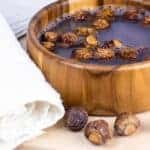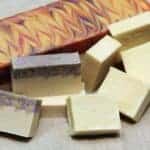Natural soap making seems quite tricky, but it is not that difficult. If we look at the benefits of natural soap, you'll want to use natural soap, no matter how many attempts you have to make to create it.
You need to understand what ingredients you’re going to use for natural soap making before starting the procedure. Butter, oils, lye, and botanicals are the natural soap ingredients you need for making soap.

You should know about the equipment required for soap making, safety measures, some primary recipes, and how to make your recipes. You should also know the cold process method for making soap.
I Tried Natural Soap Making, And I Am Hooked!
You have used different soaps in your life, but once you start using natural soaps, it will be difficult to use others. That happened to me also when I used a natural soap bar and deeply loved its effects. Then I decided to make natural soaps on my own; that's why I read a natural soap making book. I found an easy soapmaking process there, so I started making the recipe, and it was fun creating a soap. Because the soap nature was too pure, and it was not as challenging as I ever thought of.
The natural soap ingredients are not that expensive. So, a person with a low budget can also try a soap recipe. But it would not suffice to know the recipe but also be aware of safety measures, equipment, and step-by-step soap making process. Your finished soap will fully look like a commercial soap through thorough research. Don't worry; there's no need to read a full natural soapmaking book for finding a quick natural soap making recipe. Here, in this guide, you'll get all the information about homemade soap.
First, we'll discuss what natural soap is and what are the main ingredients for natural soap making. Let's discuss it deeply.
What a Natural Soap is?
Natural soap is made up of safer and naturally derived materials. For making handmade natural soap, you have to avoid all the toxic ingredients. Not only this but also don't practice such methods that require questionable procedures. It is better not to use perfumes, artificial dyes, or abrasive additives.
Those making soap for fun might not be concerned about adding only natural ingredients. But those who want to use natural products that are good for their skin would try to use all the safer ingredients. The natural soap maker should never include dyes, fragrance oils, plastic embeds, and glitter.
Main Ingredients Used In Natural Soap Making
The two essential ingredients are the heart of the natural soap. One of them is oil, and the other is lye, whose chemical name is sodium hydroxide. These chemicals, when put together, make a new compound through a controlled process: Soap.
1- Lye
One of the main elements of natural soap making is lye. It is almost impossible to make soap without using lye. For the cold process soap, lye is known as Sodium hydroxide. Some people are a bit fearful about putting lye in their soap because they may have ever experienced using a harsh lye soap. The lye chemically reacts with oils, and the final product is soap.
2- Oils and Fats
There is no restriction that you can't use a particular oil for natural soap making. That is the personal preference of the soap maker that which fat or oil he wants to use for his soap. Many soap recipes include 3 to 6 different oils. So, somewhere you'll see more oils are added while there are a few at other places. It is very uncommon that a single oil can make a perfect soap because different oils come with different properties. If one oil is good at making the soap hard, the other will be ideal for creating a lather. That's why for making a soap bar more creamy, conditioning, and hard, add different oils and fats and enjoy the remarkable results.
But be careful about adding the oils. Some people make their soaps so fatty that if more oil is added at the end, it will float in bar soap. The extra oils reject combining with lye solution and make parts of soap that differentiate the cleansing soap and moisturizing soap.
Some Essential Oils for Natural Soap Making

Shea butter
Shea butter is an ideal ingredient for soap making, but it is too hard to turn into soap. Before, it was melted and mixed at trace, but now it is a perfect replacement for palm oil. Because it is added 15% in the palm-oil-free soap base, it works well. It makes the handmade soap hard, which creates good lather. Being a quality fat, it provides the soap with better conditioning properties.
Olive oil
Olive oil is so good for soap recipes that you can add up to 100% to your soap recipe. Some soap makers go for second-grade olive oil, known as olive oil pomace, instead of extra virgin olive oil for making their soap. The reason is that extra virgin olive oil interferes with the color of soap as it has a darker shade. Olive oil pomace is lighter in color and lets the soap colorant leave its impact. Another reason for avoiding extra virgin olive oil is that it takes an extended time to trace. Olive oil is an essential oil that is suitable for every skin type.
Coconut oil
This is the most used oil for natural soap, making it hard to harden the soap perfectly. This one of the natural soap ingredients creates lots of fluffy lather and has cleansing properties which have given it a higher place among other oils. You will see most of the recipes recommending 25% usage of coconut oil or less. Most soap makers use refined coconut oil because virgin coconut oil is pricey. But here is a point virgin coconut oil smells too good, and its taste is superb.
Cocoa Butter
This combination would be an excellent option for those soap makers concerned about skin issues. This one of the great natural ingredients hards the soap well and is ideal for skin issues. Cocoa butter moisturizes dry skin and protects all sorts of skin from various problems. Only 15% coca oil is added in most recipes as a small portion of the total base oils.
Sweet Almond Oil
Almond oil is well-known among base oils for its light feel and better conditioning ability. But the good thing is that it doesn't leave any greasy effects. The massage therapists prefer this oil due to its phenomenal qualities. In soap recipes, sweet almond oil makes just a 20% portion of the base oils. This one of the natural soap ingredients creates rich lather and conditions the skin well. If you want to make your soap hard, you can opt for this superb oil.
3- Distilled Water
Distilled water is an important natural soap ingredient that replaces normal tap water because it knows the soap nature. Its task is to activate the lye, which ultimately disperses in oils. Most of the distilled water evaporates from the soaps in the curing process. It means the organic soap will be smaller than the one you had taken out from the mold before. Using tap or spring water would be a great mistake because their impurities and minerals can reduce the natural soap's shelf life and quality.
Use only that amount of water that is mentioned in the recipe. When you're experienced in making organic soap, you can lessen the water quantity, but don't do the experiments if you are a beginner. It can affect the outlook of the soap after some time.
4- Fragrance Oils
Fragrance oils are, in fact, perfumes that are made commercially for the home and toiletry industry. They are not expensive and fill the soaps with longer-lasting fragrances. A variety of fragrance oils are available in the market from which you can choose any of your favorite scents for natural soap making. If baby powder fragrance or the shampoo's coconut smell is your favorite, you should use fragrance oil in your soap.
Keep in mind that all fragrance oils (natural or synthetic) are not safe for skin use. Some fragrances are specifically for candles or other purposes that can damage the skin if used in soaps. Ensure the fragrance oil you are using for natural soap making is skin-friendly.
5- Soap Colors
There are multiple options for adding unique colors to your soap for natural soap making. You can use powder colors which can easily be purchased from specialty suppliers. Other options are to get the fresh flowers from your garden or use oils that leave their hue in the soap. The plant extracts and various other natural ingredients give a very warm shade to the soap that doesn't need any other color to add.
Some base oils like olive oil impart creamy or yellowish color that looks too beautiful. If you use light-colored oils or any white oil, the soap's color will become white. Cosmetic clays add natural color to the soap you are making, and they have different shades like green, brown, blue, pink, and yellow. Mineral pigments, micas, herbs, sugar, milk, and honey also provide beautiful natural color to the soap bars.
6- Antioxidants
Preservatives are a must for those products that have water in them. Water provides a habitat for the bacteria to grow and spoil the product. But that's not the case here; soap doesn't need any preservative because the water added in the recipe evaporates later. Superfatting is adding more oils and using less lye in soaps. For superfatting the soap, you can keep a particular oil aside for adding trace or mixing all the oils with lye. The soap will be super fast no matter which procedure you apply, but adding oil after the trace may not saponify properly.
The superfast stays in the soap bars as free-floating and conditioning oil. Different oils have different shelf lives. It doesn't happen that the oils spoil, but as they oxidize, they start smelling bad, and some orange spots appear on the soap. For curing rancidity or increasing the shelf life of your soap, you can add antioxidants, but it is optional.
Cold Process vs. Hot Process
You can make the soap through the hot process and the cold process. All the natural soap ingredients are heated and mixed for saponification in the hot process. All the ingredients cook well in an oven or a double boiler. Heat rapidly makes the soap that you can slice soon after it cools. On the other hand, the cool process takes longer in making soap. This method takes time to evaporate the water from soap but is considered the best process of soap making. The hot process soap doesn't last long for years, but the cold process soap does.
Equipment for Natural Soap Making

Let's talk about the equipment needed for making homemade soap. Interestingly, most of the equipment for natural soap making is found in your kitchen. Go to your kitchen and look for a pan you don't use most; pick it up to make your new product. It would help if you had some spoons, plastic jugs, and whisks, also get them from your kitchen, and you are good to go.
1- Soap Molds
Soap molds are available in different sizes, shapes, and materials. The silicone molds are marvelous for popping out the soap when ready. A plastic mold is also a perfect option, but it may be difficult to remove the soap from it at times. Mostly it happens when you haven't added hardening elements in the soap. The ideal soap mold for beginners is the wooden box having wax paper. If you have a wooden box at home, don't shop for new molds; use that box.
If you have a box-styled soap mold, cutting the soap into individual bars will become convenient. The wooden box insulates the soap, so you don't have to face the issue of faster cooling of the outer part of soap while the inner part is lefts warm. Have you ever experienced making a soap that was opaque outside while its center had a darker spot, it was the insulation issue? If you want to avoid this situation again, use the wooden box for better insulation.
2- Scales
Scale is one of the essential natural soap making equipment. Never make soap when you don't have a digital kitchen scale. They are not too pricey and are available everywhere, so buy them if you want to get perfect results. If you think you will measure the ingredient through a cup or teaspoon, it can work well in baking but not soap making. For soap making, precise measuring is a must. For getting the same-sized soap all the time, you must accurately measure all the ingredients with the help of a kitchen scale. This way, you will become a pro faster than using different measurements every time.
3- Temperature
Natural soap making is partly science and partly attempting all the procedures very precisely. It is much necessary to measure the lye-water and oils' temperature correctly. Because at the time of mixing, the temperature of both the materials must be the same. For an exact measurement, you must have proper measuring equipment. If you have a standard glass thermometer, it is also a good tool.
An infrared temperature gun is an inexpensive tool that everyone can buy conveniently. Dip its tip in the lye water and oils to measure the temperature. It would help if you had separate thermometers for both the oils and lye solution.
4- Utensils
It would help if you had several utensils such as large and small spoons, whisks, and spatula for mixing the liquid soap batter. Make sure all the utensils should consist of silicone or stainless steel. You can stir the oils with a stainless steel spoon, while for lye-water, use another larger spoon. As you would be blending the minerals, botanicals, and essential oils, for that, you must have a stainless steel whisk. To pour soap's lye water into the oils, use a stainless steel filter to avoid lumps spoiling your mixture. To pour the soap recipe out of the pan, you need a spatula, so if you don't have an extra at home, buy a new one.
5- Immersion Blender
Before, people used a spatula or whisk to constantly stir the soap batter and strain their hands and shoulders. But now you have a better solution for this purpose. Use an immersion blender for easier blending. Pour the soap batter into a container and stir it with your immersion blender, t would take a couple of minutes, and it will be all set for the next procedure.
6- Containers
For natural soap making, you should have various containers that must be heat-proof. The bowls or pans to pour soap base in them should be wide enough. Use only stainless steel pans because it doesn't react with the soap material or lye. Stainless steel, ceramic, glass, plastic, or pyrex containers for natural soap making because they are compatible with the soap nature.
Easy Natural Soap Making Recipe
When you have gathered all the equipment and ingredients, you can easily make the soap. But the beginners should follow the simplest and tried recipes. In the beginning, every soap maker is enthusiastic to try his recipe, but that must be left when you become an expert.
Herbal Soap Recipe
If you are growing herbs in your garden, use them for making the easiest soap recipe. The herbal soap recipe is inexpensive because it requires only four oils. Get your home mint and chop it to add to the soap mixture.
The ingredients you need for the herbal soap recipe are lye water that contains 62g sodium hydroxide and 124g distilled water. 136g refined coconut oil, 23g shea butter, 204g olive oil, 91g sunflower are other ingredients of this incredible recipe. The ingredients for after trace are 1tsp chopped herbs (thyme, peppermint, lemon balm, rosemary, or lavender). 5g rosemary essential oil, 4g peppermint essential oil, and 5g lavender essential oil.
Natural Soap Making Procedure
First of all, get all the ingredients and equipment and settle down in the area where you'll make soap. Make sure the place where you'll work must be well-ventilated. If you prefer the outdoors, that will be a better decision. But if sitting in a room, make the lye solution near a window. And, don't allow the pets and your kids to come inside that room. The distilled water's temperature has to be cool. Otherwise, the warm water can cause the lye to burst like a volcano.
Now make the lye solution by putting the lye in the water. You have to be wary while pouring the lye. Use only silicone or stainless steel spatula to stir the ingredients together. The lye and water solution become so hot and produce steam which could be hazardous for you. So, try to breathe away from this steam to save yourself from any harm.
Stir the lye solution carefully and thoroughly and when you are done with it, keep it aside to get cool.
Melt the solid oils and when there is no hard chunk left, add liquid oils. We are not talking about the essential oils but only the liquid oils like sunflower, castor, and olive oils. Add lye solution and blend them gently with an immersion blender when they are mixed. It would take 1-10 minutes to become a thick and opaque solution. Add the herbs, colorants, essential oils, and other extracts. Then pour this soap batter into molds, and your work is done. Now, the soap will become hard on its own, and then you can use it.


